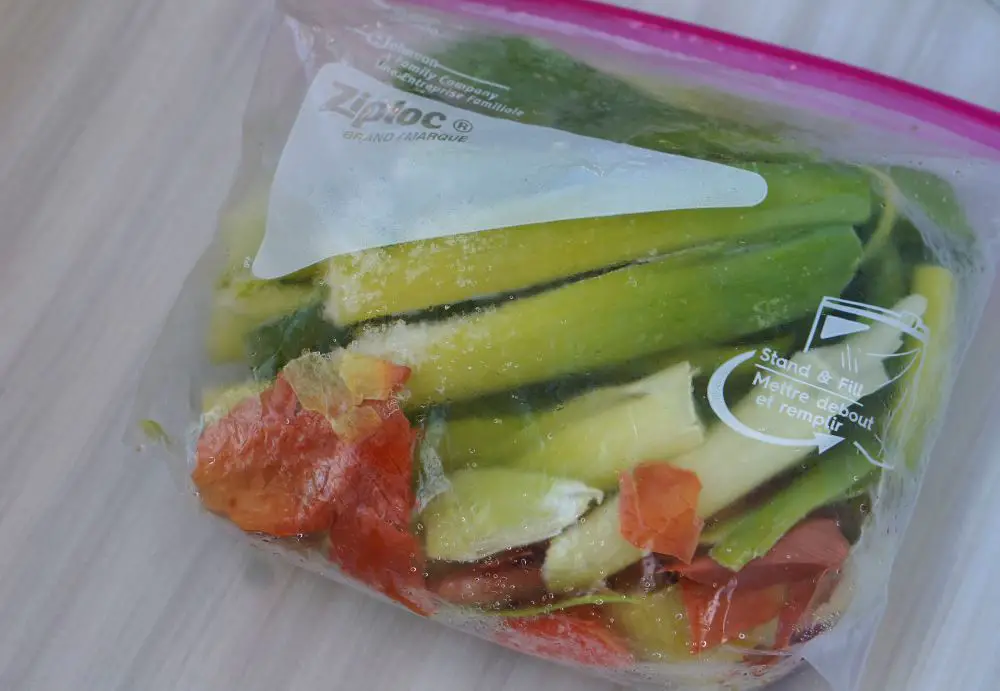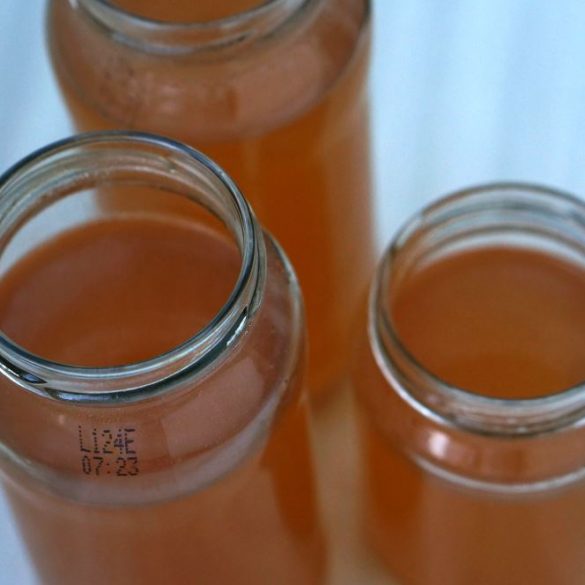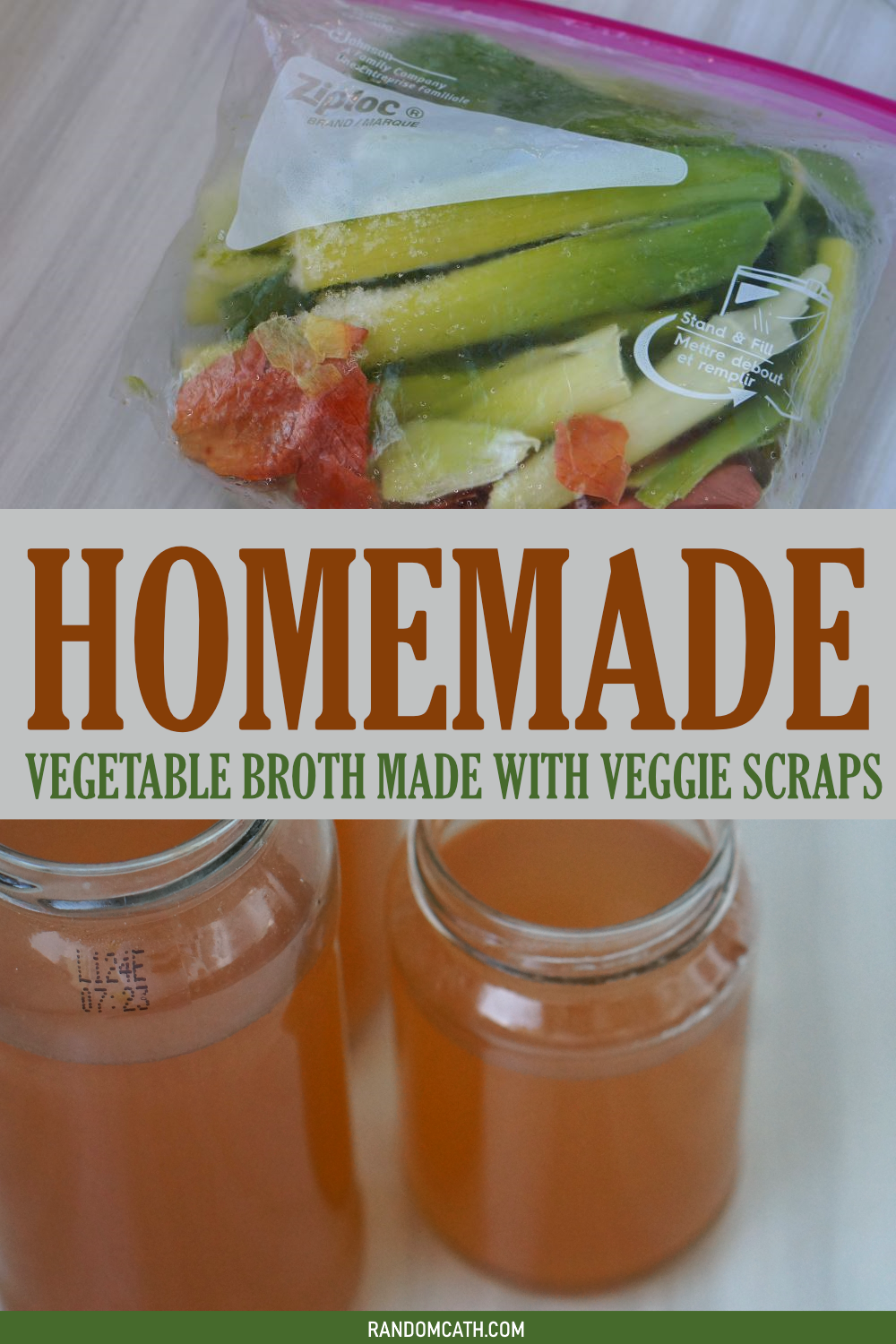If you’re cooking vegetables, you’re throwing vegetable scraps in the trash, which will eventually go to the landfill. Once in the landfill, food waste while decomposing produces methane. Methane is a greenhouse gas that’s even more potent than carbon dioxide.
Or maybe you’re able to compost or give your compost to someone else. If you’re already doing that, it’s great, you’re preventing your waste from going to the landfill and creating soil fill with nutrients.
However, isn’t it better to use it to nourish your food? Instead of throwing it in the trash or composting these veggie scraps, you can use them to give more nutrients to you and your family. By making vegetable broth at home.
Why homemade vegetable broth is better
Reducing food waste can sometimes feel tiring, so many things to prepare and figure out how to use so I’m always thankful for this recipe. I feel like I’m contributing to reducing the food waste in the world without sacrificing my limited amount of time.
Sometimes, even if we’re passionate in working towards a world with less waste, we just want a bit of time to ourselves.
I actually wrote about how to use carrot peels but if you want to use lots of your vegetable scraps in one go, your best solution is to make your own vegetable broth. Sometimes you don’t really have time to use up just a few carrot peels to reduce your food waste, better to make a few liters of vegetable broth and forget about it.
Not only that, if you’re using store-bought vegetable broth in a regular basis, you should have noticed by now the amount of sodium that it has.
I prefer to be the one to control the amount of salt my homemade meal has. I’m already Portuguese, I know that we have the tendency of putting too much salt in our food.
And we can’t overlook that you’re making vegetable broth for almost free, you’re using water and electricity but other than that, you were going to throw these vegetable scraps away, you didn’t specifically bought them to make broth. Win, win!
How to make vegetable broth more flavorful
I’m a simple person so I don’t add anything else besides vegetable scraps, if you want to fancy it up you can fry some onions and/or leeks before adding the water to enhance the flavor.
I wanted this recipe to be super super simple that anyone can make without taking lots of time. All you have to do is wash your vegetable scraps (really well!) and dump it in water.
Salt is also not added in this recipe. Fun fact: if I added salt it’d be stock not broth. That’s the difference between both.
I find that not adding fat or salt gives me freedom to use it wherever I please but feel free to make changes if it makes more sense for you.
But you can also add some special ingredients to give it a punch.
Add herbs
You can add herbs to enhance the flavor of your vegetable broth. Use fresh and not dried herbs for better taste.
If you don’t use the herbs stems for cooking (you totally should, they’re very flavorful) instead of throwing them out, using them in your vegetable broth it’s a great way to reduce your food waste even further.
Also depending on the type of herb, you should add it with your vegetable scraps or at the end. Mostly hardy herbs – thyme, rosemary, bay leaf – will be able to withstand heat for longer periods of time which other herbs won’t. Parsley and coriander for example will taste better if added almost at the end of cooking your vegetable broth – about 20min before.
Add sauces
You can add sauces that are known to increase the umami flavor to dishes. Some of them will make your broth saltier so please keep that in mind when adding salt to your dishes. Here are a few sauces that will take your broth to the next level:
- Fish sauce – one tablespoon for every 2 liters
- Soy sauce – one tablespoon for every liter
- Coconut aminos – one tablespoon for every 2 liters
These are the general guidelines but feel free to add more or less sauce depending on your preferences.
Vegetable scraps you can use for your broth
Any vegetable that usually handles temperature for some time and doesn’t turn bitter as you’ll be simmering your broth for a while.
Here’s a list of some vegetable scraps that are good for your broth:
- Onion skins
- Dark green leek tops
- Onion tops
- Carrot tops
- Carrot skins
- Celery stems
- Mushrooms stems (but they’re best used chopped finely in pastas!)
Vegetable scraps you shouldn’t use for your broth
If you’ve ever made vegetable broth before, you might wonder why did your homemade vegetable broth turn bitter. The answer? You’re using the wrong vegetables for your broth.
Cruciferous vegetables, like broccoli and Brussel sprouts, will make your broth bitter. Spinach is not a cruciferous vegetable but also isn’t very good to make vegetable broth with, your best bet would be to make soup with the stalks.
Think about it, what happens when you overcook one of these vegetables? It doesn’t taste good, right? This is the general rule to decide whether or not the vegetable scrap will be good for your broth. I’d advise you to stick with the ones that I recommended above and then start experimenting.
Potato peels can be used but I think it makes my broth too starchy so don’t personally use it. I prefer to make potato peel chips out of them. It’s your call. If you want your broth slightly thicker then potato peels will be great for this.
The fun thing about cooking is that you can experiment and make small batches and decide what you like and don’t like.
Here’s a list of vegetables that I don’t recommend you to use for your vegetable broth. Most of the scraps from these vegetables are actually good for making soup.
- Broccoli
- Brussel Sprouts
- Spinach
- Beets and beet greens
- Zucchini
- Green beans
- Avocado skins and peels
- Tomatoes
- Cucumbers
What if I don’t have enough scraps to make broth?

If you’re cooking for only one or two you’ll probably don’t have a lot of scraps to make broth.
My advice is to freeze them and once you’ve enough scraps, make your broth.
I’ve a ziploc bag that I use and wait for it to fill it up. After removing all its contents to make broth, I put it back in the freezer.
Yes I put the bag empty in the freezer so I can reuse and have the bag ready for the next time I cook. It’s a simple trick that makes a big difference as I don’t have excuses not to add my scraps.
Wash your vegetable scraps
If you’re freezing your vegetable scraps, you’ll want to make sure that everything is washed up before putting it in the freezer.
It’ll be much more difficult to clean up once you defrost your vegetables.
How to store homemade vegetable broth
In the fridge
This vegetable broth will last 3 days in the refrigerator.
In the freezer
You can also freeze your homemade vegetable broth. I’d recommend you to freeze in ready to use portions. You can freeze it in glass jars as long as you leave a bit of headspace, around 2-3 cm.
Once you’re ready to use it, just thaw the day before or use the microwave to thaw it if you need it now.
What to do with your cooked vegetable scraps
Throw nothing out!
Now you’re left with a big pile of cooked vegetable scraps.
You think you’ll put them in the trash, that’s what I did before too until I found this. But no! We’re going to use EVERYTHING. Isn’t that great?
Blend your cooked vegetable scraps until their form a paste. This paste is full of delicious goodness and will complement a ton of dishes when you want to add a bit of flavor and some consistency.
You can store it in the fridge for 2-3 days or freeze it in ice cubes for later use.
Dishes where to use vegetable scraps paste
- Risotto – Use about ½ cup
- Pasta with sauteed vegetables – Use about 2-3 tablespoons
- Soup – Use about 3-4 tablespoons
It’s pretty amazing the things we can do to reduce our food waste and even more amazing that we end up with such delicious meals with it.
Where to use vegetable broth
Using broth it’s a simple way to elevate your cooking without effort.
Just add your homemade vegetable broth in risotto and you’ll see how much it differs in taste.
But you can use your vegetable broth pretty much everywhere, from pastas to soups, it’ll make everything taste amazing. Trust me.

Ingredients
- 500gr (4 cups) of Vegetable scraps (onion skins, leek tops, carrot tops, etc, check above)
- 2 liters (9 cups) of water
Instructions
- Thoroughly wash vegetable scraps.
- Add the cold water to a pot and the vegetable scraps. Let it boil.
- Once it starts boiling, reduce heat and simmer for 1 hour.
- Remove pot from heat and strain out vegetables. Use immediately, or let cool and store it in the fridge ou freezer (check above).
Notes
- Use the strained out vegetables to make vegetable paste that you can use for your dishes.
- Double, triple the recipe if you want to make huge amounts of broth at once
- Add herbs stems to enhance flavor

